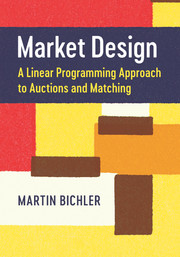12 - Outlook
from Part III - Approximation and Matching Markets
Published online by Cambridge University Press: 08 December 2017
Summary
There has been substantial progress in market design in the past few decades. The advent of the Internet and the availability of fast algorithms to solve computationally hard allocation problems has considerably extended the design space and has led to new types of markets which would have been impossible only 20 years ago. The theoretical models discussed in this book help one to understand when markets are efficient and when they are not. Many recent models for multi-object markets draw on the theory of linear programming and combinatorial optimization, at the same time adding to this theory in a fundamental way. This is one reason why market design has also found much attention in computer science and operations research lately.
Most models of markets in this book are normative and describe efficient markets with rational decision makers having independent and private values with quasilinear utility functions. In the natural sciences models are evaluated by their predictive accuracy in the laboratory and in the field. Unfortunately, the predictive accuracy of some auction models is low (see for example section 4.8). For example, Bayesian Nash equilibrium strategies require strong assumptions about a common-prior type distribution. Even if this distributional information is provided by a laboratory experiment, bidders do not always maximize payoff. Loss aversion, risk aversion, spite, or ex post regret can all affect the decision making of individuals. It is even less likely that bidders would follow a Bayesian Nash equilibrium strategy in the field, where the prior information of bidders is typically asymmetric and different between bidders.
Auction designs satisfying stronger solution concepts such as dominant strategies or ex post equilibrium strategies are promising, because they don't require a common prior assumption. However, such solution concepts are quite limiting in the design. In the standard independent-private-values model, the VCG mechanism is unique and, even if we allow the social welfare to be approximated, the scope of strategy-proof approximation mechanisms is narrow. Also, the VCG mechanism is strategy-proof for independent and private values. Jehiel et al. (2006) showed the impossibility of ex post implementation with interdependent values in multi-parameter settings. What is more, often the characteristics of market participants and the design goals are quite different from those assumed in the academic literature.
- Type
- Chapter
- Information
- Market DesignA Linear Programming Approach to Auctions and Matching, pp. 238 - 242Publisher: Cambridge University PressPrint publication year: 2017



